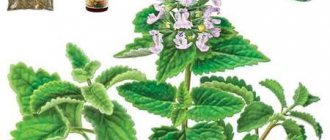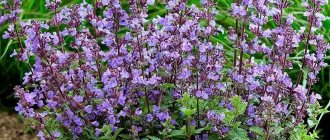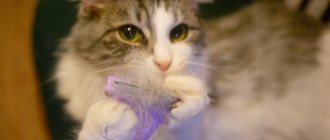Hello, dear readers!
Today we’ll talk about the benefits and harms of catnip for humans.
Catnip, or catnip, is a plant that is very stimulating to cats due to its aromatic essential oils. And for humans, this is, first of all, an excellent remedy for many health problems. Catnip is used to treat skin diseases, solve hair problems such as dandruff and irritated scalp, relieve cramps and fever, solve stomach problems, ease menstrual pain, relieve stress and improve sleep. Other benefits of this plant include benefiting the kidneys, aiding in weight loss, supporting the wound healing process, and providing the body with vital nutrients.
Back in the early 15th century, it was common among Europeans to drink tea from catnip leaves. It attracted everyone with its taste and aroma. Later it was possible to identify the healing properties of this plant.
If a cat smells catnip, it will become very excited for about 10 minutes. The animal will purr and roll on the ground. Catnip, of course, will not have such an effect on humans, but this plant can heal us from many ailments - among which, by the way, is stress. Catnip grows throughout much of Asia, including China, and parts of Europe. However, now this plant can be found in any corner of the world. The properties of catnip are associated with the presence of a certain amount of chemicals in it, such as terpenoids.
How can we take catnip? Of course, brew tea from the leaves of this plant. Inhale the essential oil that is obtained from catnip. Dried herbs can be added when preparing hot dishes. You can make tinctures with catnip. There are a lot of ways. This plant is used as an alternative to drugs. The fact that it really copes with many diseases has been proven by scientific research. We will consider below what diseases are treated with catnip.
Catnip: what it looks like
catnip looks like : it is a herbaceous plant, usually it is one long dense stem, reaching a height of 1 meter, leaves are located along the entire trunk, the largest at the base, small ones closer to the top. The leaves are triangular-ovate in shape, with jagged edges, and a fluffy surface. At the top of the stem there are flowers, small, collected in the form of brushes. There are plants with flowers of white, yellow and even light lilac. The root is long, branched, woody. Catnip blooms in July, and in August the fruits ripen - small brown nuts.
Advice
My favorite way to give catnip to my cats is to put some catnip in a sock, tie it, and give it to the cats, who start jumping, throwing the sock up, and rolling all over the floor. You can also give catnip in bulk. Just sprinkle a little on the floor or on a paper plate and watch your cat do somersaults. To extract essential oil, rub the leaves and flowers between your fingers before scattering them onto the floor. If you already have catnip in your sock, rub the sock to give the plant full effect.
Catnip: where it grows
Where does catnip ? Almost everywhere: in Europe and Asia everywhere, in Africa in the northern part. You can meet it everywhere - in wastelands, in ravines, along roads and in the forest. The plant is unpretentious, easily tolerates any climate, even in the most severe frosts the root system survives and produces new shoots in the spring. It is even possible to grow catnip in garden plots; it does not require special care.
All parts of the plant are used for medicinal purposes, so you can collect catnip constantly: it is better to hunt for shoots and leaves in the spring, flowers in June, and fruits in August or September. It is better to dry the raw materials in the open air, but you can also dry them in the oven at a low temperature.
Planting catnip in open ground
When to plant
There is nothing difficult about planting catnip in open ground. Bushes are planted in garden beds in spring. However, you can also use flower pots and containers for this. If desired, this herbaceous plant can be grown from seeds, but gardeners often use ready-made seedlings for planting; they can be purchased at a specialty store. A faster and easier way to grow catnip is to plant ready-made seedlings. Moreover, they can be planted in open ground both at the beginning of the spring and in the fall.
Optimal landing site
Catnip is not particularly demanding when it comes to growing conditions. However, it grows best in soil that allows water and air to pass through well. On sandy soil the bushes grow more fragrant
Also, when choosing a suitable location, you need to pay special attention to lighting; if possible, it is better to choose the western or southern side of the building. Catnip will also do well on a quiet slope or in an herb garden that should have good protection from the wind.
Remember that different species and varieties may have different requirements for choosing the optimal planting location. For example:
- Varieties with gray foliage. A well-warmed, sunny area is suitable for growing them, and the soil must be moisture- and breathable. At the same time, in nature, species plants with gray leaves often grow on poor rocky soil, so they do not need frequent feeding and can withstand short-term drought.
- Varieties with green foliage. They grow best in moist, nutritious soil, but the area should not be excessively soggy. They prefer well-lit areas, but also grow quite well in shaded areas. It is not recommended to plant such varieties in well-warmed areas, for example, on the south side of the house.
In order to improve the growth and development of catnip, it is recommended to add a little dolomite flour or lime during planting. When choosing a place for planting, you should also take into account that this herbaceous plant reproduces well by self-seeding.
Rules for sowing seeds
Growing catnip from seeds is quite simple, the main thing is to take into account some nuances:
- Since the seeds are very hard, immediately before sowing they are placed in the freezer, where they should remain for one night.
- After the seed material is removed from the freezer, it is poured into a container with water and left for one day. As a result of such preparation, it will be possible to destroy the protective layer of the seeds, which will significantly speed up their germination.
- Sowing of seeds is carried out in a seedling box or in open ground.
- The first shoots should appear after 1–1.5 weeks. After they grow a little, they are seated.
Planting and care of "Catnip blue carpet"
Watch this video on YouTube
Planting in open ground
The growth rate of catnip directly depends on the species and variety. Moreover, in the most suitable conditions, the bushes can grow quite dense. Therefore, when planting bushes, a distance of 0.3–0.5 meters should be maintained between them.
As a rule, 3 to 8 catnip bushes can be placed per 1 m2 of land. When planted in containers or pots, the bushes can be planted more densely, thereby creating a beautiful composition.
Step-by-step instructions for planting catnip in the ground:
- remove all weeds from the site and dig up the soil;
- the roots of the seedlings should be immersed in a container of water so that they can be saturated with moisture, thanks to this they will get sick less and quickly take root in a new place;
- make small holes in the prepared soil;
- plant the bushes in the holes to the depth at which they were in the container;
- fill the bushes with soil and make a small depression around them;
- Water the planted catnip well.
Catnip: properties
Despite its relatively poor chemical composition, catnip has a number of beneficial properties:
- For humans: calming and sedative – calms the nervous system, normalizes sleep, fights stress. Analogs - medicinal herbs: lemongrass, dandelion root, St. John's wort.
- Painkiller - effectively fights headaches, abdominal pain, and also in women during menstruation.
- Bactericidal - kills bacteria, microbes, in particular, used for abrasions and minor skin damage as a disinfectant. Black elderberry, sage, and propolis can boast the same properties.
- Antiseptic – for inflammatory processes of the nasopharynx, removes inflammation and kills viruses.
- Activates the gastrointestinal tract and normalizes digestion.
Harm
Melissa:
- It is strictly not recommended for hypotensive patients, as it reduces blood pressure even more.
- Due to the strong sedative effect, it is not recommended for those whose work requires increased concentration, reaction speed and physical activity.
- An overdose can lead to nausea, diarrhea, muscle weakness and drowsiness.
- Do not use if you are hypersensitive to the components of the plant.
Catnip:
- Do not use during pregnancy, as its effects can lead to miscarriage.
- It should not be used during lactation, as it greatly reduces the amount of milk in the mammary glands.
- With high blood pressure, since the use of catnip decoction increases it even more, and also increases tachycardia.
- It should not be used before getting behind the wheel, because the strong calming effect of the decoction negatively affects the speed of reaction and concentration.
- Do not use if you are hypersensitive to the plant.
Catnip: for humans
Although catnip is considered a pet herb, it is also very beneficial for humans. First of all, it has a positive effect on the nervous system - it calms, relieves anxiety, irritation and removes the effects of stress. Catnip decoction helps cope with severe headaches and migraines.
The herb is also very useful for the gastrointestinal tract: in addition to improving digestion, the active ingredients relieve colic and flatulence.
Catnip can be given for poisoning; it acts as an absorbent, for diarrhea and indigestion. Decoctions and infusions can be used as a disinfectant and antibacterial agent.
Excitement of the nervous system
Contact with the plant causes great excitement in cats. This is how nepetalactone works even in small concentrations. It causes short hallucinations and affects the behavior of animals. Cat owners know that using catnip can influence their pet's behavior depending on the situation.
Cats love fresh mint and eat it with pleasure. You should not be afraid that your pet will become oversaturated with grass. Animals have a barrier and will not overeat. It is unlikely that anyone has ever watched a cat continuously eating this plant. In extreme cases, stomach upset may occur.
Catnip: for sleep
Catnip is a natural sedative for humans. In reasonable quantities, it can also be used to improve sleep. If a person is constantly stressed, tired and anxious, then this plant is, after all, better suited as a mild sleeping pill, since it calms the nervous system and improves sleep.
Ashwagandha and melatonin can also be used to improve sleep and as a sleeping aid.
Catnip: for cats
Catnip is so named because this herb is primarily intended for cats. It acts similarly to valerian: animals become overly excited, somewhat aggressive and unpredictable. But catnip is essential for the cat's body, as it has a positive effect on the nervous system. It is best to give the herb after suffering stress; the active substances excite the nervous system and allow cats to “survive” an unpleasant event. But it is impossible to take this medicine frequently, firstly, addiction quickly sets in, and secondly, the animals become overly nervous and hyperactive. Catnip for cats can be purchased at a veterinary store, or you can grow it at home on a windowsill, the main thing is to keep pets away from the seedlings.
All about herbs and more
General information
Family: Lamiaceae/Lamiaceae. Botanical name: Nepeta cataria L. Pharmacy: Folk names: field balm, catnip, cat grass, cat drink, lemon catnip, mint catnip, catnip, fragrant horehound, matoshnik, sore grass.
Planet: - Venus. Zodiac sign: - Cancer. Element: - water. Deities: - Language of flowers: - maternal care. Main properties: - love, contact with animals. Description: Perennial herbaceous plant 40-100 cm high. Outwardly resembles mint. Stems are branched, tetrahedral. The leaves are opposite, cordate-ovate and oblong, pubescent, sharp, pollen-shaped. The flowers are five-membered, two-lipped, whitish, small, collected in dense paniculate-spike-shaped inflorescences. The flowers may be white or have a bluish-purple tint. The inflorescence is 3.7-8 cm long, 1.6-2.6 cm in diameter. Dry fruit, breaking up into 4 nuts. Weight of 1000 seeds (nuts) 0.53 g. Catnip is a winter-hardy plant. Light- and moisture-loving. Prefers soil that is structural, light in mechanical composition, fairly fertile and free from weeds. It has a strong, unique odor and a pleasantly bitter taste that attracts cats. Places of growth: Grows in shrubs and gardens of the steppe and forest-steppe zones of the European part of Russia, in Western Europe, in Western and Central Asia, in the Caucasus, in Western Siberia, in the Far East. Catnip is also introduced into North America, South Africa and Japan. It is cultivated in Western Europe and the USA. It was introduced into cultivation in Moldova as an aromatic plant. Grows among bushes, in vacant lots, near roads. Parts used: The above-ground part of the plant is used: stem, leaves, flowers.
Collection and preparation
Catnip is collected during the flowering period (June-August), cutting it at a height of 10 cm. It is dried in the air, under a canopy, in attics, in well-ventilated areas.
The shelf life of raw materials is 2 years. Dried raw materials have a gray-green color. If the plant is mowed in the flowering phase, it grows back and blooms again in August-September. Catnip produces the highest and most consistent yield in the second or third year of life. Medicine:
Catnip has long been used in medicine.
This plant has a diaphoretic, anti-inflammatory, expectorant, restorative, analgesic, sedative, antipyretic, hemostatic, inducing and regulating menstruation effect. Increases appetite, improves stomach and intestinal functions, improves digestion, increases the amplitude of heart contractions, and eliminates cramps. Externally, catnip is used as an antibiotic in the treatment of boils, tumors and skin inflammations. Catnip is used in the prevention of lead poisoning. In Tibetan medicine, Siberian catnip is used to gargle for tumors in the throat. Traditional Medicine:
Catnip is used in folk medicine in the form of decoctions and infusions. The decoction increases the body's defenses, has a positive effect on the cardiovascular, nervous and respiratory systems, and stimulates appetite. It is used for anemia, cough, liver diseases, jaundice, intestinal atony, hysteria, headaches, gynecological diseases, and also as an anthelmintic. The calming effect of catnip is quite strong, so it is best to take it at night. In a mixture with other plants, it is used for chronic bronchitis (soothes cough). Catnip infusion is used for anemia, exhaustion, to stimulate appetite, for stomach catarrh, convulsive cough, difficulty breathing, shortness of breath, liver diseases, women's diseases, nervous disorders, hysteria, headaches, for spasms and as an anthelmintic. Externally, the herb is used for various skin diseases. Catnip essential oil has high antimicrobial activity and fungicidal action against molds: mucor, penicillium, aspergillus. Catnip is good not only for people, but also for animals. First of all, for cats who have an inexplicable passion for this weed. What cats don’t do around this flower! They eat it, rub against it, smell it, chew the leaves. This weed makes them frisky and playful. When cats come under its influence, their mood changes: they roll on the ground in apparent ecstasy and chase imaginary mice. They come back again and again for a fix. Catnip affects both sexes, both males and females. Very aggressive and excitable cats become calmer and more balanced. They behave much calmer in stressful situations, showing no signs of aggression or fear. Phlegmatic individuals, after contact with mint, become mobile, playful and more contactable with their owners. This herbal remedy will make traveling in a car, visiting a veterinarian, or moving an animal to a new apartment easier. The essential oils contained in the leaves attract not only domestic cats, but also lions, pumas, and leopards. In ancient times, lynxes were caught using catnip as bait. Active ingredients: Contains essential oil (up to 0.5%) with a pleasant lemon odor, the main components of which are nepelactone (42%) and nepetalic anhydride, the composition also includes geraniol, dipentene, carvalol, limonene, nerol, pulegone, terpenes, citral, citronellol .
In addition to essential oil, the herb contains tannins and terpenes. Magic:
The smell of catnip helps balance emotions, has the magical ability to infuse new strength into a person, relax and refresh.
In voodoo magic, catnip is added to gris-gris bags to bring health to a person. Dried large catnip leaves are used as bookmarks in witchcraft books. Catnip will help you establish a spiritual connection with your pet. You can let your cat smell the grass and play with it. Catnip is used in love magic. It is believed to help rekindle love. You can put it in a bag of dry herbs or add it to incense, especially with rose petals. This will attract the attention of your loved one. According to gypsy magic, in order to get passion from your friend, you need to make catnip tea (one spoon of the plant per cup of boiling water). Add honey to the drink and drink before going on a date. In addition, catnip is used in love and beauty spells and spells to keep an unfaithful spouse. And here are the magical properties of catnip, described by a medieval magician: Its smoke drives creeping reptiles away from houses, And they say that if you drink it with wine, it will drive out hiccups; In the same way, love often extinguishes attraction (c) “On the properties of herbs” Odo of Mena (11th century) It is curious that with the help of catnip one can both inflame love attraction and extinguish it. How to use the plant to expel diseases or “creeping reptiles”, and in order to tame domestic animals. It turns out that if you use catnip correctly and wisely, it can be useful for a variety of purposes. Myths and Legends:
Catnip was first appreciated in Egypt, a country where cats were highly revered. This herb was sacred to the goddess Bast, the cat goddess, the goddess of the moon, fun, femininity, fertility, joy, dance and fun. This herb was given to cats who lived in the temples of the goddess Bast. Among the Celts, catnip was one of the sixteen medicinal herbs that form the basis of Druidic medicine. In the Middle Ages, in the gardens of northern Europe there were few flowers (roses, lilies and peonies), but there were many spicy and aromatic herbs: astrantia, lovage, catnip, and young. These herbs were among the required plants for planting, as they had medicinal properties and were useful in the kitchen. Also in the Middle Ages in Europe, catnip was used to terminate pregnancy: A woman will have a miscarriage after drinking or applying the grated herb. Polei (mint) Take it often and the woman will have a miscarriage. Regula also appears when drunk with warm wine; Using the same method, the lingering placenta is driven away by grass. (Recommendations from Odo of Mena from the book “On the Properties of Herbs.”) In the same Middle Ages, demons were summoned by burning a mixture of plants that included catnip. In China, herbs were grown in gardens, among them catnip. A variety of herbs were believed to attract positive energy.
Ritual for success in all endeavors Moon phase: waxing moon (the day after the new moon). Ritual: Place a small piece of clear quartz, a small piece of aventurine and a coin in the bottom of a ceramic pot, then fill the pot with soil. Plant the seeds of one of the following plants in the pot: parsley, money tree, catnip (catnip), daisy, mint or columbine. These seeds symbolize your new monetary endeavor - a new job, a new project, an investment, and the like. Take care of your plants carefully and as they grow, your welfare will also increase.
In Roger Zelazny's fantasy novel A Night in Dreary October, the dog Sniff promises his cat friend Graymalk to supply catnip booze if they survive their adventures:
“On the way to the river I found a large patch of catnip.
If we both survive, I'll get you a drink. - Thank you. She stretched. I also stretched and yawned. We nodded to each other and went our separate ways. Recipes, infusions, decoctions:
Infusion of catnip herb: 1 tablespoon of raw material is poured into 300 ml of boiling water, infused in a sealed container for 2 hours, then filtered. Take 1 tablespoon 4 times a day 30 minutes before meals. Recommended for headaches and nervous disorders
Catnip Love Potion: Used to get multiple potential partners to notice you. 2 parts dill; 1 part marjoram; 1 part catnip. To attract men, add 1/2 vanilla pod. To attract a woman, add 1/2 vanilla or cinnamon pod. (From the book “The Magic of Love” by Edaine McCoy).
Love tincture “Herbs from Bald Mountain”: red wine, catnip, hare grass, a spoonful of honey, lemon juice, spring or melt water. Add 1 tbsp to red wine. mint, 1/2 tsp. hare grass juice, 1 tbsp. honey, juice of 1 lemon, 3 tbsp. spring water. Bring to a boil, cool, leave for 3 hours and strain.
A decoction for insomnia in a child. Valerian root, hops, chamomile flowers, Baikal skullcap, passionflower (passion flower), catnip - in equal parts. Decoction: 3 tbsp. Pour 2 cups of water over spoons of the mixture, boil for 5 minutes, leave for 1 hour, strain. Drink half a glass after meals 3 times a day. Course: 2-3 weeks.
For skin diseases: Yellow gentian, blueberries, catnip, goldenseal, myrrh resin, fenugreek, comfrey, yellow sorrel, St. John's wort, blue verbena, starwort root, laurel berries, Irish moss, prickly ash, aspen, elecampane - in equal parts. Make a collection of 5-7 plants. Infusion: 3 tbsp. spoons of the mixture pour 400 ml of boiling water, leave for 30-40 minutes, strain. Drink 1/3 glass 3 times a day, but for the first 2-3 days drink 1 time a day.
Powder of happiness. 2 parts lavender, 1 part catnip, 1 part oregano. When you want to lift your spirits, sprinkle this powder in a circle on the floor or ground and sit inside it, absorbing the energies of the powder. Imagine how these energies surround you, filling you with joy.
To relax muscles and relieve pain.
Recipe for tea made from valerian, catnip and skullcap. Boil 2 cups of water. Remove from heat and add 1 teaspoon of each herb. Leave for 20 minutes. Reheat if necessary, but do not bring to a boil. Use in cooking:
Leaves and shoots are used fresh and dried as a spice for salting herring, as an additive to spicy-sweet sauces, main courses, drinks, sweet dishes, as a seasoning for salting and pickling. The plant is also used in the preparation of cheeses. In Tatarstan they flavor salads with it. Essential oil (with a strong lemon scent) adds a special smell and taste to confectionery, tonic and alcoholic drinks. Catnip is used to make tea. It is also added to the dough to give a special smell and taste to confectionery products.
Catnip: Extract
Catnip extract is an extract of the active substances of the plant, which is several times more effective than dried herb. The extract can be used to prepare traditional medicines, but it will require much less than its dry counterpart. The extract is included in dietary supplements, capsules and tablets; it is usually a compressed powder, which, when entering the body, quickly dissolves and begins to act instantly. In the online store you can buy various forms of the extract: dry powder, liquid alcohol-free essence.
Catnip: capsules
1). Supplements with catnip are available in the form of powder, liquid extract and capsules, the latter are considered the simplest and most convenient to use. You can order a variety of drugs in the online store, but you should pay attention to the dietary supplement "Catnip Herb" from Nature's way . It contains only catnip , namely, ground shoots, leaves and flowers. 1 capsule contains 380 mg of extract, but a single dosage is 760 mg, so you need to drink 2 capsules. This drug should be taken as a mild sedative or sleeping pill.
2). Dietary supplements are also available in capsules for children; in particular, you can order the drug “Calm Child” from Planetary Herbals . The drug is absolutely natural and safe and is suitable for children over 6 years old. It includes:
- Cat mint,
- Chamomile,
- Melissa,
- Hawthorn,
- Liquorice root,
- Taurine,
- Gotu Kola extract.
Children are recommended to give this drug as a sedative, as well as to improve concentration and attention. The package contains 150 capsules of 440 mg, a single dose of the drug is 880 mg, this amount of substance is contained in 2 tablets.
Catnip: instructions
The instructions for medications and dietary supplements containing catnip contain instructions for use. The main thing to remember is that you can take no more than 2500 mg per day, usually this amount is contained in six capsules or tablets.
Catnip: How to Take
How to take medications with catnip ? Drug manufacturers recommend taking two tablets three times a day, preferably with meals. Some experts definitely recommend taking medications a couple of hours before bedtime.
Catnip: contraindications
Although catnip has a positive effect on the body, there are still contraindications for use. Like any other medicinal herb, catnip can cause an allergic reaction. Pregnant women, nursing mothers and young children (under 3 years of age, or better yet wait until 6) should not take medications with this plant. Hypotonic patients should also take medications with caution, since catnip can significantly reduce already low blood pressure. In any case, it is better to consult a doctor before taking it.
Why do cats like the smell of this plant?
What mint looks like - varieties and names
It has been scientifically proven that it is the smell of lemon that has a magnetic effect on a cat. The essential components of the plant, when they enter the cat’s nasal sinuses, give a lightning-fast signal to the hypothalamus of the brain and form a wide variety of animal behavior.
The magic of influencing a pet
The principle of influencing a cat
The smell of catnip leads to a truly euphoric reaction. The pet begins to spin and roll on the floor, accompanied by increasingly strong purring. When the brain is exposed to this smell, an animal very often experiences hallucinations. Veterinarians compare this reaction to intoxication. There are a lot of different individual reactions:
- loud rumbling;
- too active washing;
- unnatural jumps;
- climbing curtains;
- sleeping in an unnatural position.
In most cases, hyperactive behavior lasts for 10-12 minutes. After this, the cat usually falls asleep.
Cat's reaction to her favorite treat
The break in the euphoric reaction can last from 30 to 60 minutes and if inhaled again, all symptoms will recur.
Is catnip harmful to cats and when should it not be used?
Even the pet’s enormous interest in catnip does not allow it to eat more than the required amount. The animal has an internal barrier that does not allow it to eat “euphoric weed” continuously.
On a note! Even if this suddenly happened, cleansing the body after an excess of catnip occurs naturally: through diarrhea or vomiting. This situation does not require the involvement of a veterinarian or the use of any medications.
The only restriction on the use of catnip concerns pregnant representatives of the species. Females can become overexcited and their shaky nervous system will react negatively to stress.
It's important to remember that cats have a natural ability to sense which plants they need and which they don't. Therefore, there is no point in restricting an animal in outdoor conditions.
Cat's lemongrass
Why doesn't my cat react to catnip?
There is a hereditary feature of some cats, which consists in a lack of interest and reaction of the body to catnip.
Approximately 30-35% of cats completely lack the receptors responsible for the reaction to this herb. This may be due to age characteristics, but more often, if the reaction does not appear in a young kitten, then it will not affect an adult cat.











